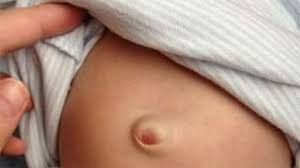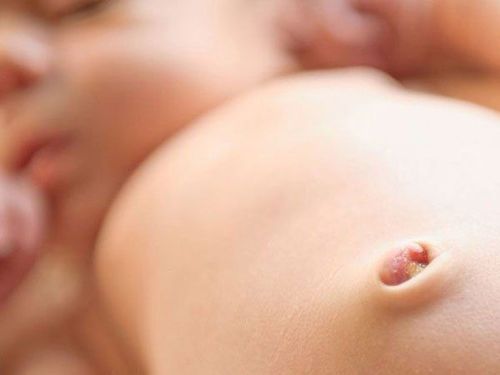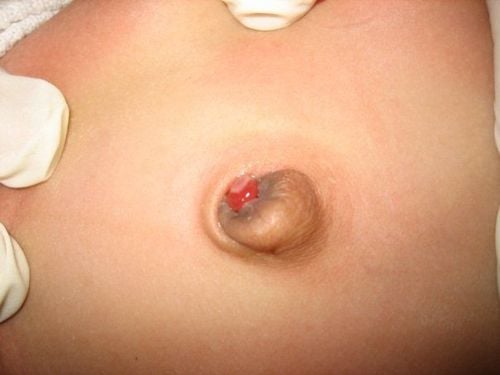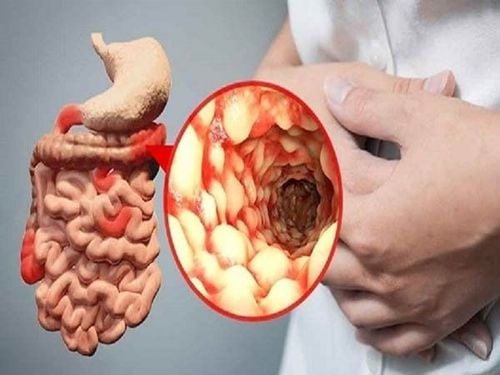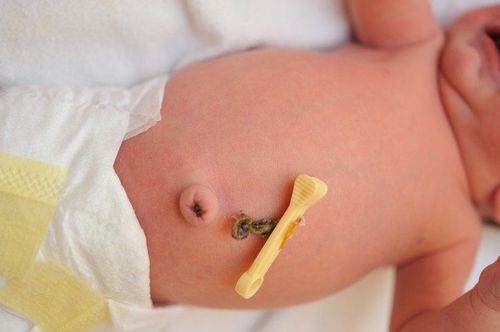This is an automatically translated article.
The article is professionally consulted by Master, Doctor Vu Quoc Anh - Pediatrician - Department of Pediatrics - Neonatology - Vinmec Danang International General Hospital.Normally, babies usually shed their umbilical cord within 8-10 days. The navel after falling off still needs to be cared for well and kept dry, but when the hygiene and care of the umbilicus is not good, it can lead to a bad condition.
1. Newborns shed their umbilical cord after how many days?
Normally, the umbilical cord of a newborn will fall off between 8 - 10 days after birth and by the 15th day, it will completely heal. However, some babies may fall out of the umbilical cord sooner or later, depending on the baby's body and how the mother takes care of it.
There are still cases where the baby's umbilical cord falls off after 2 weeks after birth, this case is still considered normal if the baby's umbilical cord is dry, clean and there are no signs of infection.

For the case of long-term baby umbilical cord loss, umbilical cord infection, premature baby, umbilical cord bandage, parenteral nutrition, light therapy. When the baby's umbilical cord has not fallen off, the mother needs to clean the umbilical cord daily and change the umbilical cord regularly, absolutely do not apply anything to the umbilical cord without a doctor's prescription or let the umbilical cord get wet. Because that will make the navel take longer to fall off and increase the risk of infection.
Trắc nghiệm: Thế nào là trẻ sơ sinh non tháng?
Trẻ sơ sinh non tháng rất cần được chăm và điều trị thật tốt để giúp giảm nguy cơ gặp phải các di chứng về tinh thần, vận động và sự phát triển sau này. Cùng theo dõi bài trắc nghiệm dưới đây để có thể nhận biết trẻ sơ sinh non tháng và có thêm kiến thức chăm sóc, nuôi dưỡng tốt nhất cho trẻ.The following content is prepared under supervision of Thạc sĩ, Bác sĩ y khoa, Ma Văn Thấm , Nhi , Phòng khám Đa khoa Quốc tế Vinmec Dương Đông(Phú Quốc)
2. Navel pathology in infants
2.1 Localized umbilical cord infection Localized umbilical cord infection: Loss of normal boundary between skin and umbilical cord, umbilical cord inflammation red, purulent, sometimes oozing blood. Umbilical Care: This is a very important thing to do every day for the purpose: to reduce infection, to quickly dry and fall off the navel. Home care and prevention: Mothers need to be instructed on how to care for the umbilicus at home 1-2 times a day with 0.9% physiological saline and instructed to bring the baby back for follow-up examination if the umbilical cord is still bleeding. pus or fluid after 2 days or when the infection gets worse. Prevention: Ensure sterility before and after birth. Cut and tie the umbilical cord with sterile instruments. Wash hands before caring for children. 2.2 Diffuse umbilical cord infection Severe umbilical cord infection: The infection spreads to surrounding connective tissue, causing hard red inflammation around the navel, creating an umbilical halo larger than 2cm in diameter. Children with signs of systemic infection (high fever, lethargy, refusal to breastfeed).
Infection spread by blood : See the pus in the skin. in the extremities in the lungs... accompanied by symptoms of sepsis (multiple organ damage). Culture umbilical pus, pus abscess.
2.3 Umbilical Tetanus Clostridium Tetani bacteria enter the baby's body through the cut in the umbilical cord. Tetanus bacteria can live in anaerobic conditions. After the tetanus bacteria enter the child's body, it usually does not immediately give rise to obvious symptoms.
During the incubation period (average 7 days, sooner or later depending on the level of toxins secreted by the bacteria). Depending on the incubation period, it is possible to predict whether a part of the disease is severe or mild.
2.4 Single umbilical artery disease Normally in the umbilical cord connecting mother and fetus there are 3 blood vessels: 2 arteries and 1 vein. The most common umbilical cord abnormality is 1 umbilical artery, accounting for 0.08 to 1.9% of total pregnancies.
Other possible structural abnormalities include: urogenital system, cardiovascular system, musculoskeletal system, nervous system, and chromosomal abnormalities. When there is a single umbilical artery, it is necessary to carefully examine the fetal morphology.
At birth, about 30% of babies have an umbilical artery, with other congenital abnormalities. Careful examination of the umbilical cord and other associated abnormalities should be sought. For proper treatment.
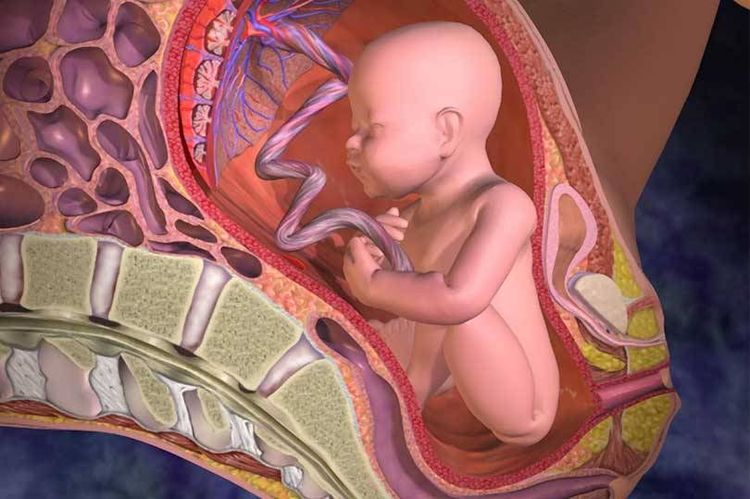
2.5 Umbilical granulomatosis Umbilical granulomatosis is a delayed epidermalization after umbilical cord shedding that causes overgrowth of granulomatous tissue.
Cause: Usually umbilical granuloma occurs in babies with delayed umbilical cord shedding, usually more than 6-8 days after birth.
2.6 Existence of the urachal tube Normally, the urachal tube connecting the urogenital sinus and the umbilicus will be closed and fibrosis into the umbilical-bladder ligament during the fetal period. Existence of the umbilical cord is the existence of a tube connecting the navel to the bladder.
Thus, urine can back up from the bladder into the navel. Damage to the junction between the bladder and the navel to allow urine to pour into the umbilical cord, the umbilical cord always leaks continuously, sometimes the child has a UTI. This pathology during surgery. Releasing the umbilical cord of the urinary tract.
2.7 Umbilical Hernia The umbilical cord is attached to the abdomen when the baby is born. Within 5-7 days after birth, the umbilical cord gradually atrophies and falls off, the wound heals and forms the baby's navel. As the child grows older, the hole in the abdominal wall will automatically close, but in some cases the abdominal muscles do not close properly leading to an umbilical hernia.
2.8 Caring for a newborn's navel after shedding The umbilical cord after shedding still needs to be well taken care of and kept dry. Every day, the mother needs to clean the bottom of the umbilical cord 1-2 times with a cotton ball or gauze soaked in a little alcohol 70 degrees or alcohol iodine and continuously bandage until the baby's navel is completely healed.
Mother should fold the edge of the diaper down so that the umbilical cord is open, do not let urine stick to the navel, when the umbilical cord falls off, and when the baby's umbilical cord has fallen off most of the time, do not pull the umbilical cord with your hands.
As a key area of Vinmec Health system, Pediatrics Department always brings satisfaction to customers and is highly appreciated by industry experts with:
Gathering a team of top doctors and nurses in Pediatrics : consists of leading experts with high professional qualifications (professors, associate professors, doctorates, masters), experienced, worked at major hospitals such as Bach Mai, 108.. Doctors All doctors are well-trained, professional, conscientious, knowledgeable about young psychology. In addition to domestic pediatric specialists, the Department of Pediatrics also has the participation of foreign experts (Japan, Singapore, Australia, USA) who are always pioneers in applying the latest and most effective treatment regimens. . Comprehensive services: In the field of Pediatrics, Vinmec provides a series of continuous medical examination and treatment services from Newborn to Pediatric and Vaccine,... according to international standards to help parents take care of their baby's health from birth to childhood. from birth to adulthood Specialized techniques: Vinmec has successfully deployed many specialized techniques to make the treatment of difficult diseases in Pediatrics more effective: neurosurgery - skull surgery, stem cell transplantation. blood in cancer treatment. Professional care: In addition to understanding children's psychology, Vinmec also pays special attention to the children's play space, helping them to have fun and get used to the hospital's environment, cooperate in treatment, improve the efficiency of medical treatment. Master. Dr. Vu Quoc Anh has nearly 10 years of experience as a resident doctor and treating doctor at Hue Central Hospital and Danang Children's Hospital. Currently, he is a Pediatrician - Vinmec Da Nang International General Hospital.
Please dial HOTLINE for more information or register for an appointment HERE. Download MyVinmec app to make appointments faster and to manage your bookings easily.






